By Elizabeth Spach, Virginia Management Fellow, SCHEV
Many Virginia colleges and universities transitioned to remote learning, either fully or via a hybrid model of instruction, for the Fall 2020 semester because of the COVID-19 pandemic. As students, institutions and policy makers grapple with how COVID-19 has changed higher education, SCHEV wanted to take a look at distance learning trends prior to COVID-19 using SCHEV’s “Distance Education Trends at Virginia Institutions” report. These data provide a baseline of “face-to-face” (F2F) learning trends from 1995-2019. SCHEV will publish 2020-21 data in the Fall of 2021 once institutions submit their annual student-level course enrollment data.
For the purposes of this Insight, F2F instruction is a label attached to students who were taking all courses face-to-face. Conversely, “distance learning” applies to students exclusively taking distance learning courses. “Hybrid” students represent a mixture of F2F and distance learning courses. Some of these hybrid students might have taken only one distance learning course and the rest F2F, or vice versa. Distance learning can include online learning but also other non-online instructional methods that deliver content at a distance (e.g., synchronous telecommunication, video tapes, correspondence courses). Old Dominion University’s (ODU) Teletechnet distance learning initiative illustrates how distance learning changed in the last 25 years. It began in early 1994 as a satellite course and transitioned to online courses taught through ODUOnline. Prior to ODUOnline, students had remote access to ODU courses through satellites and televisions with two-way video connections. In 1997, Teletechnet provided courses to active-duty Navy sailors through the Ships to Sea Program.
The Growth of Hybrid Learning
The number of students taking only F2F classes has decreased steadily since 1995 when SCHEV first collected these data. As of the 2019-20 school year, 41% of students were exclusively F2F, compared to two thirds in 2008-09 and almost 90% in 1995-96.
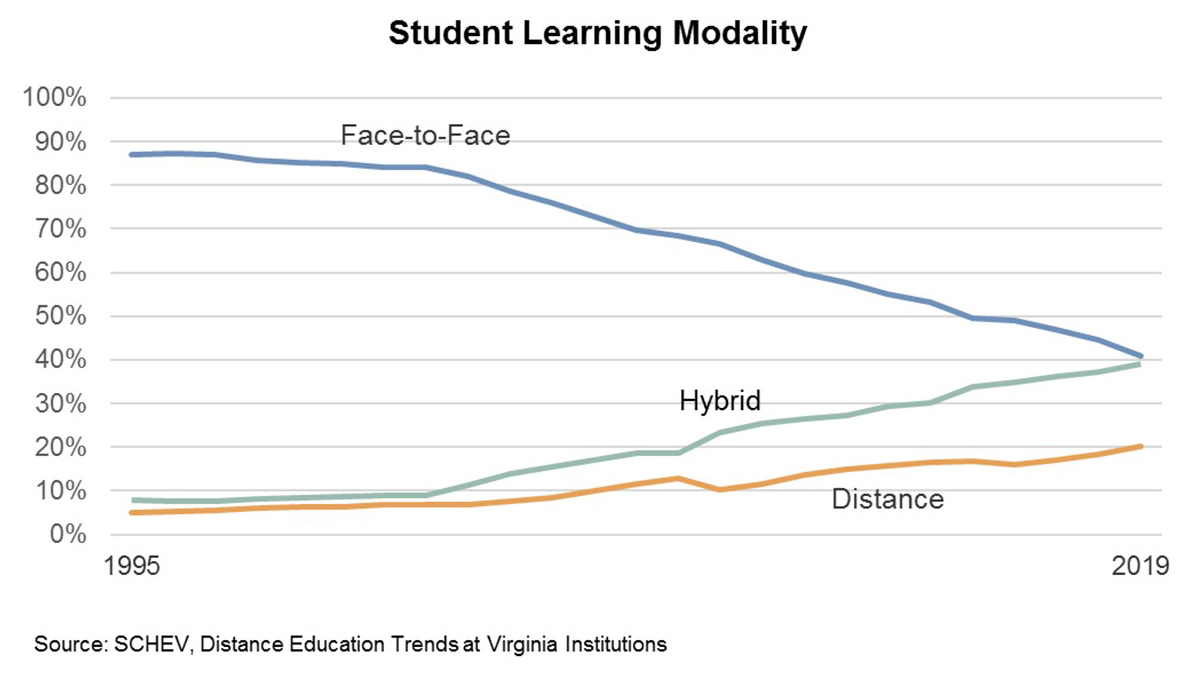
The fact that 41% of students take exclusively F2F courses, does not mean however, that the other 59% are taking all distance learning courses. The fastest growing mode of instruction is among hybrid students who take a mixture of distance learning and F2F courses. Roughly two-thirds of hybrid students, however, take only six credits or fewer distance learning courses. While the percentage of hybrid students is increasing, the majority of hybrid students in Virginia take courses face-to-face.
The percentage of exclusively F2F students, however, varies greatly depending on the sector. While all sectors have seen a decrease in F2F students since 1995-96, public two-year institutions and private nonprofit four-year institutions have seen the largest decreases. For the 2019-20 school year, the F2F rate declined to one third or less at these institutions compared to half of students attending public four-year colleges and universities.
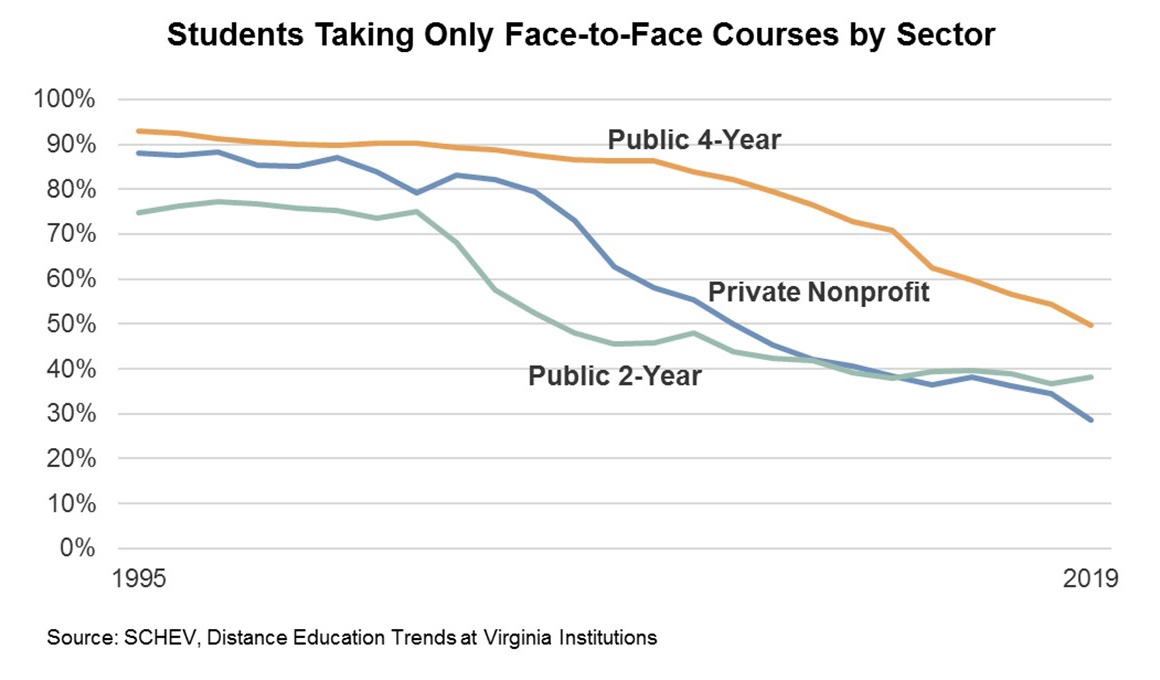
A closer look at exclusively F2F students by institution shows that variation also exists within sectors. While private nonprofit F2F enrollment overall has decreased sharply since 1995, Liberty University is driving much of this decrease. Liberty’s enrollment grew tenfold between 1995 and 2019 and now accounts for more than 60% of all private, nonprofit enrollments. In 2019, only four percent of Liberty University students were exclusively F2F compared to two-thirds of all other private, nonprofit students. When excluding Liberty University, private nonprofit institutions have the highest rates of exclusively F2F learning for 2019.
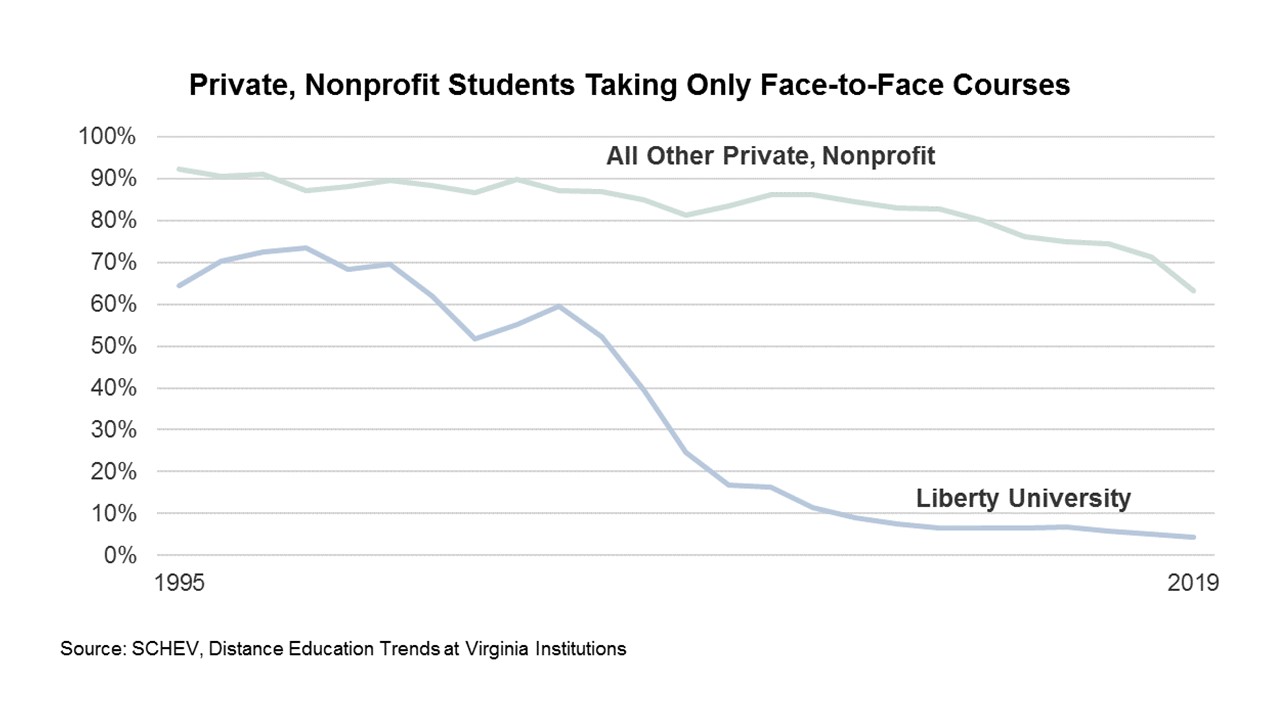
All public four-year institutions saw decreases in exclusively F2F students since 1995 except for Christopher Newport, which increased three percentage points, and Virginia Military Institute, which remained exclusively F2F. Some institutions lost F2F students at faster rates than others. Virginia Tech, Radford and Norfolk State had the largest F2F decline, decreasing more than 60 percentage points since 1995. F2F decreases were less severe at the University of Virginia and William & Mary where F2F decreased by less than 10 percentage points. Christopher Newport was the only public four-year institution to have a greater percentage of F2F students in 2019 than in 1995.
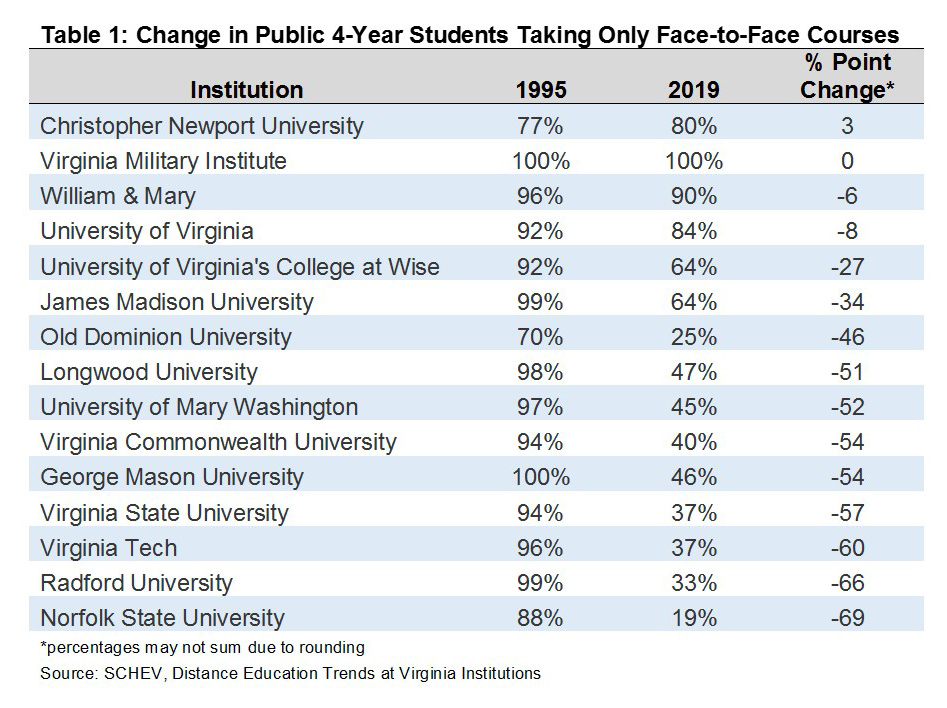
Face-to-Face (F2F) Learning by Program Level
How students experience their education varies by program level as well. Bachelor’s degree seekers are more likely than students at other program levels to be F2F. As of 2019-20, nearly half of those seeking a bachelor’s degree are F2F students compared to roughly one third of graduate, certificate and associate degree students.
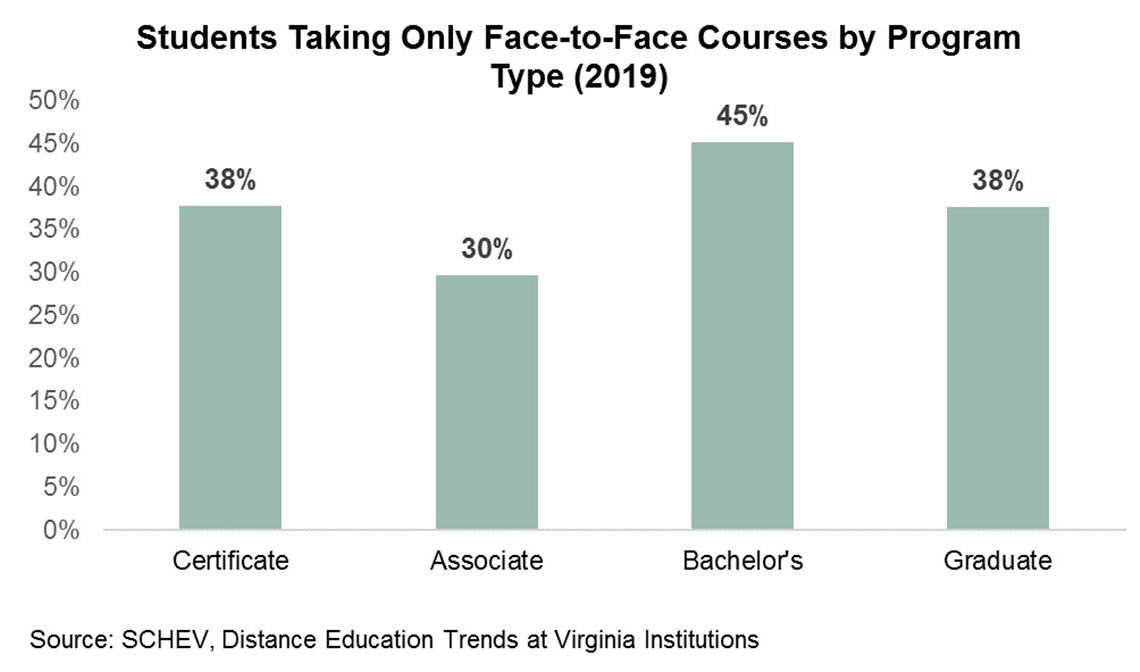
While bachelor’s degree seekers are more likely to be in a F2F setting, the percentage of F2F students has decreased steadily since 1995 for all program types. Associate degree seekers have seen the largest decrease in the percentage of F2F students dropping from 78% in 1995 to 30% in 2019.
The Takeaway
Even before COVID-19, the percentage of F2F students was decreasing across the Commonwealth. Less than half of FTE students in 2019 were F2F with some sectors, institutions and programs experiencing more change than others. Some institutions are rapidly switching to distance learning (Liberty) while others have been almost 100% F2F since 1995 (VMI, W&M).
As decreases in F2F and increases in distance learning continue, closing the digital divide becomes even more important. A previous Insight post on Virginia’s Digital Divide in Education found that one in five Virginia students (Pre-K-12 and college) lack either high speed internet or a computer in their home. Governor Northam convened a COVID-19 Education Work Group that addressed this divide through increasing access and making technology and broadband more affordable. On an institutional level, schools can ensure all students have access to the distance learning resources they need. Virginia State University (VSU) leveraged CARES funds and private donations to provide $500 technology stipends to students so they could buy a computer with technology that worked best for them. The university bookstore administered the program, and VSU used existing licenses (SPSS, Office 360, etc.) in computer labs to provide cloud services to students. Colleges and universities also are putting infrastructure in place to make distance learning easier. The Shared Services Distance Learning (SSDL) program through the Virginia Community College System (VCCS) lets students take online courses with instructors from another VCCS school. Information portals, like the Online Virginia Network, have the potential to make it easier for students to obtain a degree in a distance learning environment.
It remains to be seen exactly how greatly COVID-19 will affect F2F learning for the 2020-2021 school year. While SCHEV will not know this information until late Fall 2021, we hope that this post illuminates current trends and serves as a benchmark for future analysis after COVID-19.
*Methodology
Data for this analysis comes from the annual student-level course enrollment data institutions submit to SCHEV every Fall. They report these data annually instead of each term to limit their administrative burden. Institutions determine course delivery for each undergraduate and graduate course using Southern Regional Education Board guidelines. “Traditional instruction” (F2F) includes on campus and off campus courses where 50% or less of course content is electronically delivered. Distance learning is not necessarily synonymous with online learning and includes courses where more than 50% of content is electronically delivered, or no significant site attendance is required. This includes e-learning such as web, site-to-site two-way audio/video, video tapes and correspondence courses. A student is labeled “face-to-face,” “hybrid” or “distance learning” depending on whether their courses are face-to-face or distance. Face-to face and distance students must take all of their courses through that medium while a hybrid student takes at least one F2F and one distance learning course.
The “Distance Education Trends at Virginia Institutions” report measures distance learning for full time equivalent (FTE) students which is not the same as the total headcount of students. FTE standardizes the count of students based on their credit hours proportional to a standard for full-time students (30 credits per year for undergraduate and professional students, 24 credits for graduate students).
Welcome to Insights, SCHEV's platform to interpret and communicate data and policy with the overall goal of informing policy-making, engaging institutions and drawing attention to these resources. Centered around SCHEV's nationally leading data collection, each Insight will visualize complex ideas and help inform funding and policy decisions.
